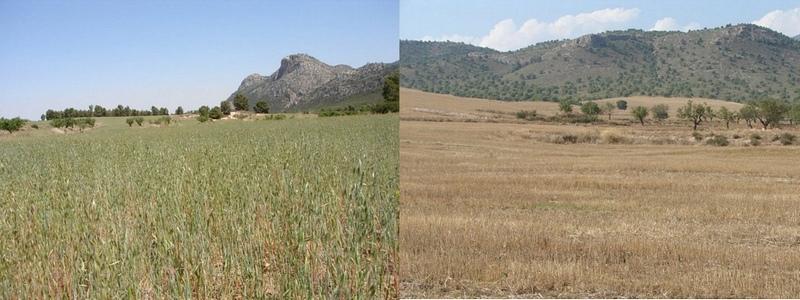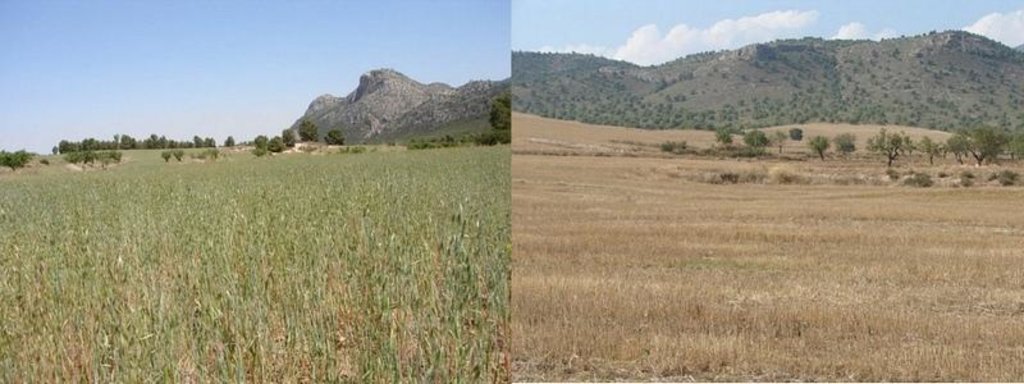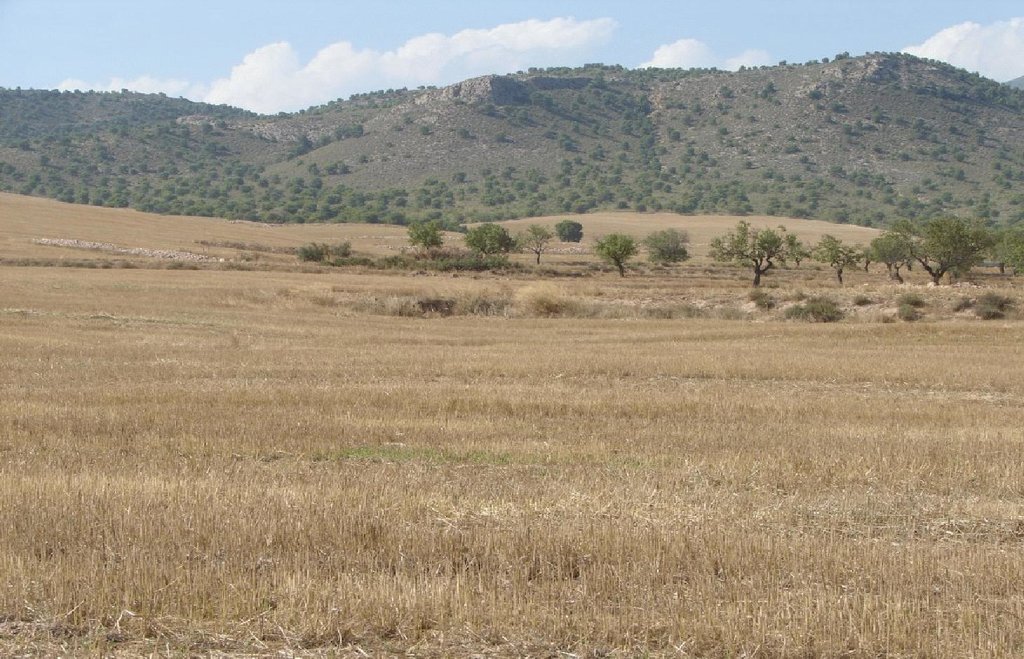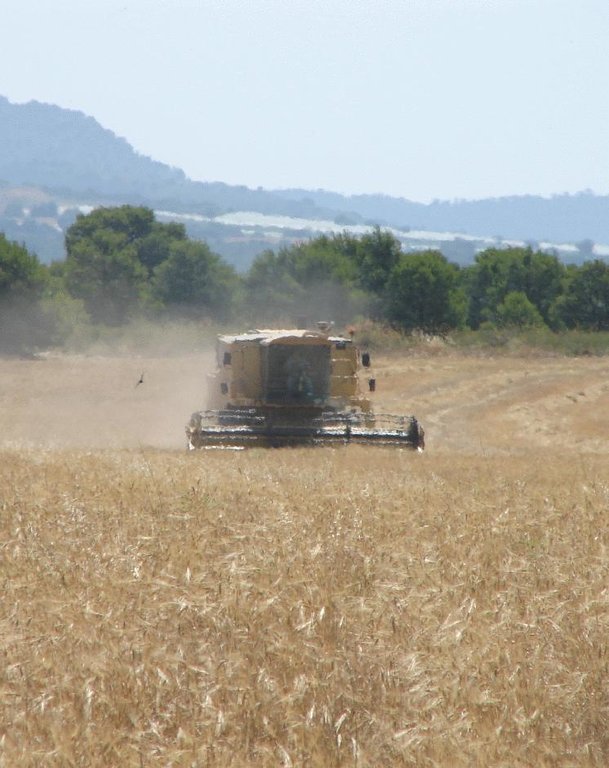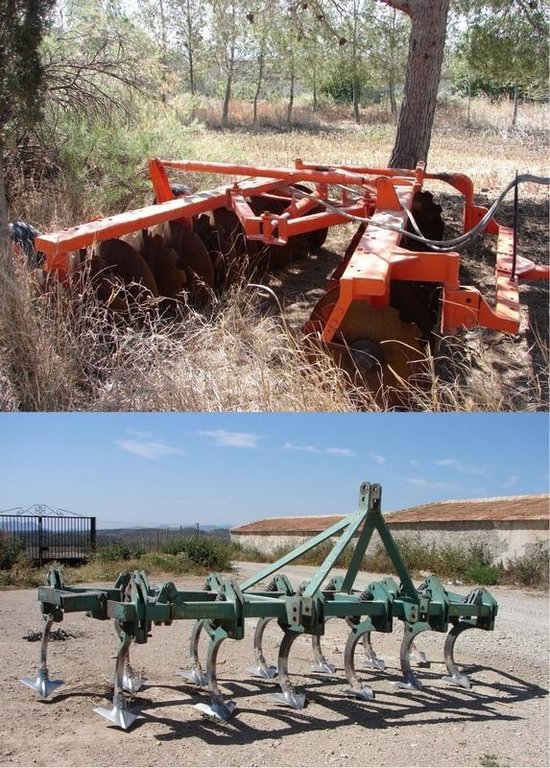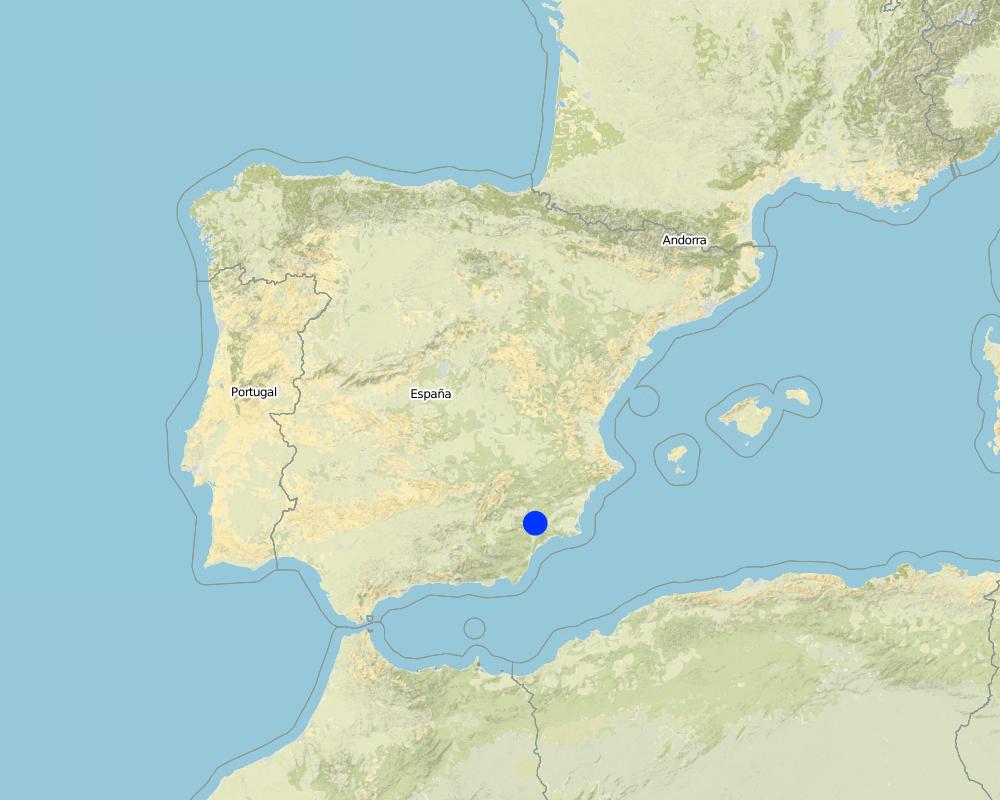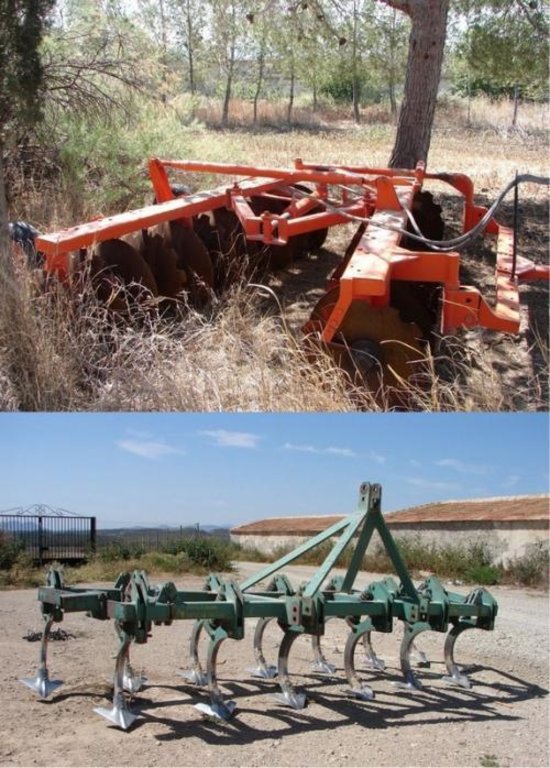Reduced contour tillage of cereals in semi-arid environments [Espanha]
- Criação:
- Atualização:
- Compilador/a: Joris De Vente
- Editor: –
- Revisor: Deborah Niggli
Labranza reducida de cereal en contra de la pendiente en ambientes semi-áridos (ES)
technologies_939 - Espanha
Veja as seções
Expandir tudo Recolher tudo1. Informação geral
1.2 Detalhes do contato das pessoas capacitadas e instituições envolvidas na avaliação e documentação da tecnologia
Ibáñez Torres Ascensión
+34.968 36 66 87 / +34 699 65 36 16
ascension.ibanez@carm.es
Rural development service (CARM) - Consejería de Agricultura y Agua Murcia
Murcia
Espanha
usuário de terra:
Escamez Antonio
608 862 629 / 968 43 82 50
Farmer, Alhagüeces, Zarzilla de Totana
Espanha
Nome do projeto que facilitou a documentação/avaliação da Tecnologia (se relevante)
DESIRE (EU-DES!RE)Nome da(s) instituição(ões) que facilitou(ram) a documentação/ avaliação da Tecnologia (se relevante)
EEZA-CSIC (EEZA-CSIC) - Espanha1.3 Condições em relação ao uso da informação documentada através de WOCAT
Quando os dados foram compilados (no campo)?
12/06/2008
O compilador e a(s) pessoa(s) capacitada(s) aceitam as condições relativas ao uso de dados documentados através do WOCAT:
Sim
1.4 Declaração de sustentabilidade da tecnologia descrita
A tecnologia descrita aqui é problemática em relação a degradação da terra de forma que não pode ser declarada uma tecnologia de gestão sustentável de terra?
Não
1.5 Referência ao(s) questionário(s) sobre as abordagens da GST
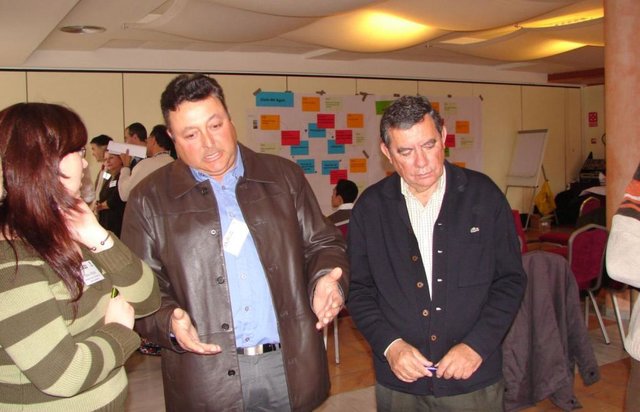
Regional rural development programme [Espanha]
Regional development programme to protect natural resources and stimulate rural economies.
- Compilador/a: Joris De Vente
2. Descrição da tecnologia de GST
2.1 Descrição curta da tecnologia
Definição da tecnologia:
Reduced contour tillage in a rotational system of winter cereals and fallow land.
2.2 Descrição detalhada da tecnologia
Descrição:
This technology is a type of conservation tillage with minimal economic effort and is adapted to semi-arid conditions. Tillage is reduced to a maximum of three times surface tillage (20-30cm) in two years with a disc- or a chisel-plough. The disc-plough is only used where there is a dense weed or crop residue cover. The disc-plough breaks-up the soil top layer better than the chisel-plough, while the chisel tends to plough slightly deeper (~30cm) than the disc-plough (~20cm). The advantage of the chisel-plough is that it leaves a higher surface roughness and is less destructive to soil aggregates. Under conventional tillage, fields are ploughed up to five times every two years, once with a mouldboard plough. In both systems, cereals are cropped in a rotational system with fallow land. Cereals are sown in autumn (October) and harvested in June followed by a fallow year. Under reduced tillage the crop residues are left on the field throughout the autumn and winter periods. This provides increased protection against soil erosion. Tillage is performed on fallow land in early spring (March-April) to prepare the land for sowing in October. With conventional tillage, fields are ploughed with a mouldboard plough in autumn. Traditional sowing machinery can be used so no investments are needed in specialised equipment. Tillage is performed parallel to the contour lines to prevent rill and gully formation. No herbicides are required since annual weeds are mixed with the upper soil layer during ploughing. Owing to increased organic matter content and a better infiltration capacity, soil water retention capacity, soil humidity and crop yields will increase within 3-5 years after implementation.
The aim of this technology is to increase the soil organic matter content by retaining it in soil aggregates and to reduce soil erosion by water and tillage. The higher infiltration capacity and better surface cover with crop residues in autumn and winter protects the soil against water erosion, reducing soil erosion by over 50% and runoff by 30%. In addition, the better organic matter content increases overall soil quality in terms of soil structure and water holding capacity. Compared to traditional multiple tillage operations with a mouldboard plough, under reduced tillage, tillage erosion is reduced by having fewer tillage operations, but also through tillage of fallow land resulting in lower tillage erosion rates than secondary tillage operations of already loosened soil. Fuel use by tractors is decreased, leading to a reduction of 40% in production costs and reduced CO2 emissions. Some studies showed that in first 2-3 years after implementation, the soil can be denser and have a lower infiltration capacity than under traditional tillage regimes. Yet, when the organic matter content and soil structure have increased, infiltration rates are higher than under traditional ploughing and result in increased soil water content and crop yields.
The technology is applied on loamy soils with a calcareous substrate, of shallow to medium depth, and slopes are gentle to moderate (5-15%). The climate is semi-arid with a mean annual rainfall of around 300 mm. Droughts, centred in summer commonly last for more than 4-5 months. Annual potential evapotranspiration rates greater than 1000 mm are common. The production system is highly mechanised and market oriented but depends strongly on agricultural subsidies.
2.3 Fotos da tecnologia
2.5 País/região/locais onde a tecnologia foi aplicada e que estão cobertos nesta avaliação
País:
Espanha
Região/Estado/Província:
Murcia
Especificação adicional de localização:
Guadalentin catchment
Map
×2.6 Data da implementação
Caso o ano exato seja desconhecido, indique a data aproximada:
- menos de 10 anos atrás (recentemente)
2.7 Introdução da tecnologia
Especifique como a tecnologia foi introduzida:
- atráves de inovação dos usuários da terra
- durante experiências/ pesquisa
Comentários (tipos de projeto, etc.):
Conservation tillage is well-known from other areas around the world. Here, it was adapted to the semi-arid and low productivity conditions of this area.
3. Classificação da tecnologia de GST
3.1 Principal/principais finalidade(s) da tecnologia
- Reduz, previne, recupera a degradação do solo
3.2 Tipo(s) atualizado(s) de uso da terra onde a tecnologia foi aplicada

Terra de cultivo
- Cultura anual
Comentários:
Major land use problems (compiler’s opinion): There is a lack of water for irrigation of crops limiting the crop types that can be planted as well as the crop yield of dryland farming. A lack of water availability seriously limits the production potential of the soil and results in a low vegetation/crop cover. The relatively high soil erosion rates cause various off-site related problems (i.e. flooding, reservoir siltation) and on-site problems (i.e. gully formation and reduced soil depth).
Major land use problems (land users’ perception): Lack of water for irrigation of crops limiting the crop types that can be planted as well as the crop yield of dryland farming.
Livestock is grazing on crop residues.
3.3 Mais informações sobre o uso da terra
Abastecimento de água para a terra na qual a tecnologia é aplicada:
- Precipitação natural
Número de estações de cultivo por ano:
- 1
Especifique:
Longest growing period in days: 220 (Nov - Jun)
3.4 Grupo de GST ao qual pertence a tecnologia
- Perturbação mínima ao solo
3.5 Difusão da tecnologia
Especifique a difusão da tecnologia:
- Uniformemente difundida numa área
Caso a tecnologia seja uniformemente difundida numa área, indique a área coberta aproximada:
- 10-100 km2
Comentários:
The exact area is not known, but the technology is widely applied throughout the province of Murcia and the district of the upper Guadalentin.
3.6 Medidas de GST contendo a tecnologia

Medidas agronômicas
- A1: cobertura vegetal/do solo
- A3: Tratamento da superfície do solo
- A4: Tratamento do subsolo
Comentários:
Type of agronomic measures: rotations / fallows, breaking crust / sealed surface, breaking compacted topsoil, minimum tillage, non-inversion tillage, contour tillage
3.7 Principais tipos de degradação da terra abordados pela tecnologia

Erosão do solo pela água
- Wt: Perda do solo superficial/erosão de superfície
- Wg: Erosão por ravinas/ravinamento

Deteriorização física do solo
- Pk: quebra e ressecamento

Degradação da água
- Ha: aridificação
Comentários:
Main type of degradation addressed: Wt: loss of topsoil / surface erosion, Pk: sealing and crusting, Ha: aridification. Secondary types of degradation addressed: Wg: gully erosion / gullying.
Main causes of degradation: soil management (Crust formation, loss of soil organic matter, loss of soil structure, loss of available soil water and finally soil loss .), disturbance of water cycle (infiltration / runoff) (Reduced infiltration capacity causing runoff and soil erosion), inputs and infrastructure: (roads, markets, distribution of water points, other, …) (Low market price of cereals)
Secondary causes of degradation: Heavy / extreme rainfall (intensity/amounts) (High intensity erosive rainfall is common), droughts (Dry periods and dry years require higher water availability), governance / institutional (Spatial planning of land use and control of soil management)
3.8 Redução, prevenção ou recuperação da degradação do solo
Especifique o objetivo da tecnologia em relação a degradação da terra:
- Prevenir degradação do solo
- Reduzir a degradação do solo
4. Especificações técnicas, implementação de atividades, entradas e custos
4.1 Desenho técnico da tecnologia
4.2 Especificações técnicas/ explicações do desenho técnico
Photo of the disc-plough used for superficial ploughing (~20cm depth) where there is a large amount of crop residue and/or perennial vegetation. Bottom: Chisel-plough
Technical knowledge required for field staff / advisors: moderate. Technical knowledge required for land users: moderate.
Main technical functions: control of raindrop splash, control of dispersed runoff: retain / trap, control of dispersed runoff: impede / retard, control of concentrated runoff: impede / retard, improvement of ground cover, improvement of surface structure (crusting, sealing), improvement of topsoil structure (compaction), improvement of subsoil structure (hardpan), increase in organic matter, increase of infiltration, increase / maintain water stored in soil. Secondary technical functions: increase of surface roughness, increase in nutrient availability (supply, recycling,…)
Rotations / fallows: cereals are followed by 1-2 years of fallow
Breaking crust / sealed surface / compacted topsoi: Disc-plough or chisel-plough
Minimum tillage: Disc-plough or chisel-plough
Non-inversion tillage: Disc-plough or chisel-plough
Contour tillage: Disc-plough or chisel-plough
4.3 Informação geral em relação ao cálculo de entradas e custos
Outro/moeda nacional (especifique):
Euro
Indique a taxa cambial do dólar norte americano para a moeda local (se relevante): 1 USD =:
0,63
Indique a média salarial da mão-de-obra contratada por dia:
79.00
4.5 Custos e entradas necessárias para a implantação
| Especifique a entrada | Unidade | Quantidade | Custos por unidade | Custos totais por entrada | % dos custos arcados pelos usuários da terra | |
|---|---|---|---|---|---|---|
| Mão-de-obra | Disc plough | piece | 1,0 | 397,0 | 397,0 | 100,0 |
| Custos totais para a implantação da tecnologia | 397,0 | |||||
Comentários:
The disc plough costs USD 7937, but assuming an average farm size of 10 ha, this means a per ha cost of $794 (Prices are for spring 2008). Two parties are sharing the costs. Initial investment per party = USD 397
4.6 Atividades recorrentes/manutenção
| Atividade | Tipo de medida | Periodicidade/frequência | |
|---|---|---|---|
| 1. | Tillage with disc-plough | Agronômico | Before seeding once every 2 years in a rotational fallow system |
4.7 Custos e entradas necessárias pata a manutenção/atividades recorrentes (por ano)
| Especifique a entrada | Unidade | Quantidade | Custos por unidade | Custos totais por entrada | % dos custos arcados pelos usuários da terra | |
|---|---|---|---|---|---|---|
| Mão-de-obra | Labour | 1,0 | 12,0 | 12,0 | 100,0 | |
| Equipamento | Machine hours | 1,0 | 50,0 | 50,0 | 99,0 | |
| Custos totais para a manutenção da tecnologia | 62,0 | |||||
Comentários:
Machinery/ tools: Disc-plough and/or chisel-plough and tractor
The costs are indicated per ha of land where the technology is implemented.
4.8 Fatores mais importantes que afetam os custos
Descreva os fatores mais determinantes que afetam os custos:
Fuel price is the most determinate factor affecting the costs.
5. Ambiente natural e humano
5.1 Clima
Precipitação pluviométrica anual
- <250 mm
- 251-500 mm
- 501-750 mm
- 751-1.000 mm
- 1.001-1.500 mm
- 1.501-2.000 mm
- 2.001-3.000 mm
- 3.001-4.000 mm
- > 4.000 mm
Especificações/comentários sobre a pluviosidade:
Dry period in summer during 3-4 months (June – August/September)
Zona agroclimática
- Semiárido
Thermal climate class: subtropics. The higher parts are generally somewhat colder
5.2 Topografia
Declividade média:
- Plano (0-2%)
- Suave ondulado (3-5%)
- Ondulado (6-10%)
- Moderadamente ondulado (11-15%)
- Forte ondulado (16-30%)
- Montanhoso (31-60%)
- Escarpado (>60%)
Formas de relevo:
- Planalto/planície
- Cumes
- Encosta de serra
- Encosta de morro
- Sopés
- Fundos de vale
Zona de altitude:
- 0-100 m s.n.m.
- 101-500 m s.n.m.
- 501-1.000 m s.n.m.
- 1.001-1.500 m s.n.m.
- 1.501-2.000 m s.n.m.
- 2.001-2.500 m s.n.m.
- 2.501-3.000 m s.n.m.
- 3.001-4.000 m s.n.m.
- > 4.000 m s.n.m.
Indique se a tecnologia é aplicada especificamente em:
- Não relevante
5.3 Solos
Profundidade do solo em média:
- Muito raso (0-20 cm)
- Raso (21-50 cm)
- Moderadamente profundo (51-80 cm)
- Profundo (81-120 cm)
- Muito profundo (>120 cm)
Textura do solo (solo superficial):
- Médio (limoso, siltoso)
- Fino/pesado (argila)
Matéria orgânica do solo superficial:
- Médio (1-3%)
- Baixo (<1%)
5.4 Disponibilidade e qualidade de água
Lençol freático:
5-50 m
Disponibilidade de água de superfície:
Precário/nenhum
Qualidade da água (não tratada):
apenas para uso agrícola (irrigação)
Comentários e outras especificações sobre a qualidade e a quantidade da água:
There is a lowering of groundwater table due to overexploitation for irrigation purposes.
5.5 Biodiversidade
Diversidade de espécies:
- Baixo
5.6 Características dos usuários da terra que utilizam a tecnologia
Orientação de mercado do sistema de produção:
- Misto (subsistência/comercial)
- Comercial/mercado
Rendimento não agrícola:
- >50% de toda renda
Nível relativo de riqueza:
- Média
Indivíduos ou grupos:
- Indivíduo/unidade familiar
Nível de mecanização:
- Mecanizado/motorizado
Gênero:
- Homens
Indique outras características relevantes dos usuários da terra:
Land users applying the Technology are mainly common / average land users.
Difference in the involvement of women and men: Traditionally most agriculture is done by men in this region.
Population density: 10-50 persons/km2
Annual population growth: < 0.5%
15% of the land users are rich and own 20% of the land. 80% of the land users are average wealthy and own 75% of the land. 5% of the land users are poor and own 5% of the land.
Off-farm income specification: There is no difference in the ones who apply the technology and those who do not. Most farmers do have an off-farm income for example from hunting, work in a factory or office.
5.7 Média da área de terra própria ou arrendada por usuários da terra que utilizam a tecnologia
- < 0,5 ha
- 0,5-1 ha
- 1-2 ha
- 2-5 ha
- 5-15 ha
- 15-50 ha
- 50-100 ha
- 100-500 ha
- 500-1.000 ha
- 1.000-10.000 ha
- > 10.000 ha
É considerado pequena, média ou grande escala (referente ao contexto local)?
- Pequena escala
5.8 Propriedade de terra, direitos de uso da terra e de uso da água
Propriedade da terra:
- Indivíduo, intitulado
Direitos do uso da terra:
- Indivíduo
Direitos do uso da água:
- Indivíduo
Comentários:
All cropland is privately owned. Water use is organised by permits to water extraction from aquifers on individual basis. Water rights are provided and controlled by the Water authority of the Segura river basin (CHS).
5.9 Acesso a serviços e infraestrutura
Educação:
- Pobre
- Moderado
- Bom
Assistência técnica:
- Pobre
- Moderado
- Bom
Emprego (p. ex. não agrícola):
- Pobre
- Moderado
- Bom
Mercados:
- Pobre
- Moderado
- Bom
Energia:
- Pobre
- Moderado
- Bom
Vias e transporte:
- Pobre
- Moderado
- Bom
Água potável e saneamento:
- Pobre
- Moderado
- Bom
Serviços financeiros:
- Pobre
- Moderado
- Bom
6. Impactos e declarações finais
6.1 Impactos no local mostrados pela tecnologia
Impactos socioeconômicos
Produção
Produção agrícola
Comentários/especificar:
Depending on local conditions yield may be the same or increase slightly. Sometimes in first year of implementation crop production is slightly reduced.
Renda e custos
Despesas com insumos agrícolas
Comentários/especificar:
Possible investment in a Disc-plough during first years
Rendimento agrícola
Comentários/especificar:
Depends on crop yield. Gasoline use is decreasing.
Carga de trabalho
Comentários/especificar:
Reduced labour: Less ploughing required.
Impactos socioculturais
Atenuação de conflitos
Impactos ecológicos
Ciclo hídrico/escoamento
Colheita/recolhimento de água
Comentários/especificar:
On the long term higher infiltration capacity of the soil
Escoamento superficial
Comentários/especificar:
about 10% reduction
Solo
Umidade do solo
Cobertura do solo
Perda de solo
Comentários/especificar:
reduction by about 45%
Ressecamento/ selagem do solo
Ciclo e recarga de nutrientes
Clima e redução de riscos de desastre
Emissão de carbono e gases de efeito estufa
Comentários/especificar:
Less tractor use
6.2 Impactos externos mostrados pela tecnologia
Cheias de jusante
Sedimentação a jusante
Sedimentos transportados pelo vento
Danos em áreas vizinhas
Danos na infraestrutura pública/privada
6.3 Exposição e sensibilidade da tecnologia às mudanças climáticas graduais e extremos/desastres relacionados ao clima (conforme o ponto de vista dos usuários da terra)
Mudança climática gradual
Mudança climática gradual
| Estação do ano | Tipo de mudança climática/extremo | Como a tecnologia lida com isso? | |
|---|---|---|---|
| Temperatura anual | aumento | não bem |
Extremos (desastres) relacionados ao clima
Desastres meteorológicos
| Como a tecnologia lida com isso? | |
|---|---|
| Temporal local | bem |
| Tempestade de vento local | bem |
Desastres climatológicos
| Como a tecnologia lida com isso? | |
|---|---|
| Seca | não bem |
Desastres hidrológicos
| Como a tecnologia lida com isso? | |
|---|---|
| Inundação geral (rio) | bem |
Outras consequências relacionadas ao clima
Outras consequências relacionadas ao clima
| Como a tecnologia lida com isso? | |
|---|---|
| Período de crescimento reduzido | bem |
Comentários:
The crop type is sensitive to changes in water availability under the semi arid conditions.
6.4 Análise do custo-benefício
Como os benefícios se comparam aos custos de implantação (do ponto de vista dos usuários da terra)?
Retornos a curto prazo:
levemente negativo
Retornos a longo prazo:
levemente positivo
Como os benefícios se comparam aos custos recorrentes/de manutenção(do ponto de vista dos usuários da terra)?
Retornos a curto prazo:
levemente positivo
Retornos a longo prazo:
levemente positivo
Comentários:
When a disc-plough was not already used in normal farming operations, this implies a slightly negative influence on farm income during establishment.
6.5 Adoção da tecnologia
Entre todos aqueles que adotaram a tecnologia, quantos adotaram espontaneamente, ou seja, sem receber nenhum incentivo material/pagamentos?
- 0-10%
Comentários:
Reduced tillage is not subsidised and so is implemented 100% voluntary. However, there are subsidies for parts of the technology such as contour ploughing and rotational farming allowing a fallow period (1-2 years) after cereals. Practically 100 % of farmers use these subsidies.
There seems to be a growing public awareness of the fact that frequent deep rotational ploughing is not always necessary.
6.7 Pontos fortes/vantagens/oportunidades da tecnologia
| Pontos fortes/vantagens/oportunidades na visão do usuário da terra |
|---|
| The technology is low cost and even generates more farm income due to lower fuel use. The increased soil cover through winter and the contour ploughing have a notable positive effect on rill and gully formation in the fields. (How to sustain: The tillage between two fallow periods might be avoided to further reduce fuel use and maintain surface cover intact. However, in order to apply for subsidies for agricultural extensification, farmers are obliged to plough fallow land once a year in order to eliminate weeds.) |
| Pontos fortes/vantagens/oportunidades na visão do compilador ou de outra pessoa capacitada |
|---|
| This is a low-cost technology that requires limited initial investments in equipment and potentially results in a slightly increased farm income, as well as a decrease in land degradation and an increase in soil quality and water-holding capacity. (How to sustain: In some higher areas with sufficient rainfall, the technology might be adapted to conservation tillage with direct sowing, reducing the tillage operations even more. However, this implies an important investment in machinery and a high level of organisation at the agricultural cooperation level.) |
| An increased soil surface cover throughout autumn and winter provides a good protection against soil erosion reducing rill and gully formation. (How to sustain: Sometimes a field is left fallow for two consecutive years, but it is still ploughed between them. This ploughing might be avoided as well.) |
6.8 Pontos fracos, desvantagens/riscos da tecnologia e formas de superá-los
| Pontos fracos/desvantagens/riscos na visão do usuário da terra | Como eles podem ser superados? |
|---|---|
| In order to apply for subsidies for cereal cultivation in a rotation system with fallow, farmers are obliged to plough after each fallow period to control weeds, even when two consecutive years of fallow are applied. This is considered unnecessary | It might be worthwhile to test the need for this and look for alternatives without ploughing. |
| Pontos fracos/vantagens/riscos na visão do compilador ou de outra pessoa capacitada | Como eles podem ser superados? |
|---|---|
| The most important weakness of this technology is that it does not significantly improve farm income and so may not be stimulating enough for farmers to apply | Provide information on all the advantages of good soil management that include many costs for society (including floods, reservoir siltation, etc.) and stress the fact that reduced tillage will lead to less work for the same or slightly higher profit. |
7. Referências e links
7.1 Métodos/fontes de informação
- visitas de campo, pesquisas de campo
- entrevistas com usuários de terras
- entrevistas com especialistas em GST
7.2 Referências às publicações disponíveis
Título, autor, ano, ISBN:
Angás, P., Lampurlanés, J. and Cantero-Martínez, C., 2006. Tillage and N fertilization: Effects on N dynamics and Barley yield under semiarid Mediterranean conditions. Soil and Tillage Research, 87(1): 59-71.
Disponível de onde? Custos?
Internet
Título, autor, ano, ISBN:
Holland, J.M., 2004. The environmental consequences of adopting conservation tillage in Europe: reviewing the evidence. Agriculture, Ecosystems & Environment, 103(1): 1-25.
Disponível de onde? Custos?
Internet
Título, autor, ano, ISBN:
Hoogmoed, W.B. and Derpsch, R., 1985. Chisel ploughing as an alternative tillage system in Parana, Brazil. Soil and Tillage Research, 6(1): 53-67.
Disponível de onde? Custos?
Internet
Título, autor, ano, ISBN:
Josa, R. and Hereter, A., 2005. Effects of tillage systems in dryland farming on near-surface water content during the late winter period. Soil and Tillage Research, 82(2): 173-183.
Disponível de onde? Custos?
Internet
Título, autor, ano, ISBN:
Lampurlanés, J. and Cantero-Martínez, C., 2006. Hydraulic conductivity, residue cover and soil surface roughness under different tillage systems in semiarid conditions. Soil and Tillage Research, 85(1-2): 13-26.
Disponível de onde? Custos?
Internet
Título, autor, ano, ISBN:
Lampurlanés, J., Angás, P. and Cantero-Martínez, C. 2002. Tillage effects on water storage during fallow, and on barley root growth and yield in two contrasting soils of the semi-arid Segarra region in Spain. Soil and Tillage Research, 65(2): 207-220
Disponível de onde? Custos?
Internet
Título, autor, ano, ISBN:
López-Fando, C., Dorado, J. and Pardo, M.T., 2007. Effects of zone-tillage in rotation with no-tillage on soil properties and crop yields in a semi-arid soil from central Spain. Soil and Tillage Research, 95(1-2): 266-276.
Disponível de onde? Custos?
Internet
Título, autor, ano, ISBN:
Martin-Rueda, I., Muñoz-Guerra, L.M., Yunta, F., Esteban, E., Tenorio, J.L. and Lucena, J.J., 2007. Tillage and crop rotation effects on barley yield and soil nutrients on a Calciortidic Haploxeralf. Soil and Tillage Research, 92(1-2): 1-9
Disponível de onde? Custos?
Internet
Título, autor, ano, ISBN:
Ozpinar, S., 2006. Effects of tillage systems on weed population and economics for winter wheat production under the Mediterranean dryland conditions. Soil and Tillage Research, 87(1): 1-8.
Disponível de onde? Custos?
Internet
Título, autor, ano, ISBN:
Van Muysen, W., Govers, G., Van Oost, K. and Van Rompaey, A., 2000. The effect of tillage depth, tillage speed and soil condition on chisel tillage erosivity. Journal of Soil and Water Conservation(355-364).
Disponível de onde? Custos?
Internet
Título, autor, ano, ISBN:
Van Muysen, W., Govers, G., Bergkamp, G., Roxo, M. and Poesen, J., 1999. Measurement and modelling of the effects of initial soil conditions and slope gradient on soil translocation by tillage1. Soil and Tillage Research, 51(3-4): 303-316
Disponível de onde? Custos?
Internet
Título, autor, ano, ISBN:
Van Oost, K., Govers, G., De Alba, S. and Quine, T.A., 2006. Tillage erosion: a review of controlling factors and implications for soil quality. Progress in Physical Geography, 30(4): 443-466.
Disponível de onde? Custos?
Internet
Título, autor, ano, ISBN:
CARM 2008. Programa de Desarrollo Rural de la Región de Murcia 2007-2013 Tomo I. 508pp
Disponível de onde? Custos?
http://www.carm.es/neweb2/servlet/integra.servlets.ControlPublico?IDCONTENIDO=4689&IDTIPO=100&RASTRO=c431$m1219
Título, autor, ano, ISBN:
Poesen, J., van Wesemael, B., Govers, G., Martinez-Fernandez, J., Desmet, P., Vandaele, K., Quine, T. and Degraer, G., 1997. Patterns of rock fragment cover generated by tillage erosion. Geomorphology, 18(3-4): 183-197.
Disponível de onde? Custos?
Internet
Links e módulos
Expandir tudo Recolher tudoLinks

Regional rural development programme [Espanha]
Regional development programme to protect natural resources and stimulate rural economies.
- Compilador/a: Joris De Vente
Módulos
Não há módulos


